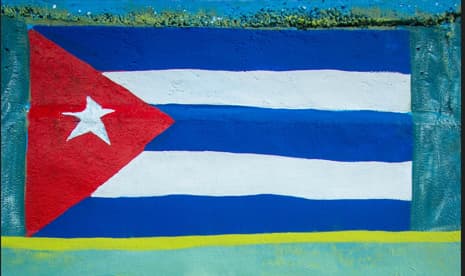Cuba
Cuba Flag : A Symbol of Revolution and Independence
The flag of Cuba is a symbol of revolution and independence. It is a simple yet powerful design that features five alternating stripes of blue and white. With a red equilateral triangle at the hoist. A white five-pointed star is centered in the triangle.
The flag’s colors have symbolic significance. The departments into which the Island was then divided are represented by the blue stripes. The independence of the independentist ideal is represented by the white ones. The red triangle represents liberty, equality, and brotherhood.
Cuba’s flag was first flown in 1849, during the Ten Years’ War (1868-1878), a rebellion against Spanish rule. It was officially adopted in 1902 when Cuba gained its independence from Spain.
The flag has been flown through many turbulent times in Cuba’s history. It has been flown during the Cuban Revolution (1953-1959), the Cold War, and the Special Period (1990-1994). Today, the flag continues to be a symbol of hope and unity for the Cuban people.
The Design of the Flag
The design of the Cuba flag is simple yet effective. The Cuba flag’s design was conceived in 1849 by the visionary Narciso López and Miguel Teurbe Tolón. is a masterpiece of symbolism:
- Blue Stripes: The flag’s foundation comprises three bold horizontal blue stripes. These vivid azure bands pay homage to the three departments into which Cuba was divided at the time of the flag’s creation: Occidental, Central, and Oriental.
- White Stripes: Elegantly contrasting the blue, two pristine white stripes symbolize purity. A deep longing for independence, and the unwavering commitment of Cuban patriots.
- Red Triangle: On the flag’s hoist side, a striking red equilateral triangle represents the core values of strength, constancy, and the profound sacrifices made by Cuban revolutionaries.
- White Star: At the heart of the red triangle shines a single white five-pointed star. Affectionately known as “Estrella Solitaria” or the Lone Star. It embodies the enduring spirit of independence and freedom that has defined Cuba’s history.
Historical Significance:
The Cuba flag is not just a colorful banner. But a living testament to the nation’s resilience and determination:
- On May 19, 1850, Cuba’s flag was first hoisted on Cuban soil. During López’s audacious attempt to liberate the town of Cárdenas from oppressive Spanish rule.
- While this initial uprising faltered. The flag became an enduring symbol of resistance and patriotism.
- It was formally adopted as Cuba’s national flag on May 20, 1902. Following the country’s hard-fought independence from Spain after the Spanish-American War.
- The Cuba flag has continued to wave proudly through various chapters of the nation’s history. Including the revolutionary changes brought about by Fidel Castro’s ascent to power in 1959.
Comparative Perspective:
The striking similarity between Cuba’s flag and that of Puerto Rico is not coincidental. López and Tolón designed both flags in 1895.
These flags, with their reversed colors, symbolize the historical and cultural ties shared by the two Caribbean islands, both of which were once Spanish colonies and later U.S. territories.
Exploring Historical Flags:
Beyond the current national flag, Cuba’s tumultuous history has witnessed the use of several other flags by different groups and movements striving for independence:
- The Demajagua Flag: Resembling the Chilean flag, it was created by Carlos Manuel de Céspedes in 1868 to mark the start of the Ten Years’ War against Spain.
- The Lares Flag: A blue flag with a white cross and red stars, used by Puerto Rican revolutionaries supporting Cuban independence in 1868.
- The Yara Flag: A red flag with a white cross and blue stars, utilized during the Ten Years’ War.
- The Bayamo Flag: A white flag with a blue cross and red stars, another symbol of rebellion during the Ten Years’ War.
- The 26th of July Movement Flag: A black-and-red horizontal bicolor flag used by Fidel Castro and his followers during their revolutionary movement against Fulgencio Batista’s dictatorship.
The Flag Today
Cuba’s flag is still flown today as a symbol of the country’s independence and its people’s revolutionary spirit. It is a reminder of the sacrifices that have been made for Cuba’s freedom, and it inspires hope for a better future.
The national flag is also a popular tourist souvenir. It can be found in shops all over Cuba, and it is a popular item to take home as a reminder of the country’s rich history and culture.
The Power of the Flag
The flag of Cuba is more than just a piece of cloth. It is a symbol of the country’s history, culture, and people. Also a symbol of hope and unity. It is a symbol of revolution and independence.
The flag of Cuba is a powerful reminder of what the Cuban people have achieved, and what they are still capable of achieving. It is a symbol that inspires pride, courage, and determination.
The flag of Cuba is a symbol that will continue to fly for many years to come. It is a symbol that will never be forgotten.
Cuba’s Flag and the Lone Star Flag
The flag of Cuba also goes by the name of Estrella Solitaria or the Lone Star flag. This is because the white five-pointed star at the center of the national flag is the only star on the flag.
The national flag is also sometimes referred to as the Bandera de la estrella solitaria, which is Spanish for “flag of the lone star.”
The flag of Cuba is similar to the flag of Puerto Rico, which also features a white five-pointed star in a red equilateral triangle.
However, the flag of Puerto Rico has a different color scheme, with five alternating stripes of red and white.
The Puerto Rican flag (bottom) and the flags of Cuba (top) are similar for a reason. Narciso López, a pro-independence refugee living in New York City, created Cuba’s flag in 1849. A commission of exiles in New York chose the Puerto Rican flag’s design in the middle of the 1890s.
The flags of Cuba and Puerto Rico are a reminder of the shared history and culture of the two islands. They are also a symbol of the struggle for independence and self-determination.
Why are Cuban and Puerto Rican flags similar?
The Cuban and Puerto Rican flags are similar because they share a common history and cultural heritage. Both flags were designed by Narciso López and Miguel Teurbe Tolón in 1849 during the mid-19th century when both Cuba and Puerto Rico were Spanish colonies.
López, a Venezuelan-born Cuban revolutionary, and Tolón, a Cuban poet, collaborated on the design of these flags as part of their efforts to promote independence from Spanish colonial rule. The flags were intended to symbolize the shared struggle for freedom in the Spanish-speaking Caribbean.
What flag is like Cuba?
The flag that is most similar to Cuba’s flag is the flag of Puerto Rico. As mentioned earlier, the Cuban and Puerto Rican flags share a nearly identical design, with the main difference being the arrangement of colors.
While Cuba’s flag has three blue stripes and two white stripes with a red triangle and a white star, the Puerto Rican flag reverses the colors, featuring three red stripes and two white stripes with a blue triangle and a white star.
These flags reflect the historical and cultural connections between the two islands.
Conclusion:
Cuba’s flag is more than just a piece of cloth; it is a tapestry of history, a testament to resilience, and an embodiment of a nation’s enduring spirit.
Its colors, stripes, and stars tell the story of Cuba’s past, present, and future. As you explore the island’s culture, landscapes, and people, let Cuba’sflag remind you of the indomitable human spirit and the unyielding quest for freedom and independence.
Frequently Asked Questions(FAQ’s)
Does Cuba and Puerto Rico share the same flag?
While the Cuban and Puerto Rican flags are strikingly similar in design and share historical roots, they are distinct flags that represent separate nations.
Cuba and Puerto Rico each have their own unique national identities, governments, and flags. The similarity in flag design is a reflection of their shared history of colonial rule and aspirations for independence.
What is Cuba’s flag and its meaning?
Cuba’s flag is composed of five blue and white horizontal stripes. The center is occupied by the red triangle and the white five-pointed star. In contrast, that is what the Puerto Rican flag displays. The three blue stripes stand in for the three departments that at the time separated Cuba.
The flag’s symbolism includes:
- Blue Stripes: Represent the three departments Cuba was divided into during its colonial period.
- White Stripes: Symbolize purity, the desire for independence, and the patriot cause.
- Red Triangle: Stands for strength, constancy, and the bloodshed by Cuban revolutionaries.
- White Star: Represents independence and freedom.
The national flag is a powerful symbol of Cuba’s history, struggle for independence, and its enduring commitment to freedom.
Cuba flag meaning:
As mentioned earlier, Cuba’s flag’s meaning is deeply symbolic. The blue stripes represent historical divisions within Cuba.
The white stripes symbolize purity and independence, the red triangle signifies strength and sacrifice, and the white star represents independence and freedom.
Cuba flag emoji:
The Cuba flag emoji is represented by combining the regional indicator symbols 🇨 (Regional Indicator Symbol Letter C) and 🇺 (Regional Indicator Symbol Letter U). These symbols are combined to display Cuba’s flag emoji 🇨🇺 on supported platforms.
Cuba map:
Cuba is an island nation located in the Caribbean Sea. It is situated east of the Yucatán Peninsula (Mexico), south of Florida (USA), west of Hispaniola (comprising Haiti and the Dominican Republic), and north of Jamaica and the Cayman Islands. Cuba is the largest country in the Caribbean by land area.
Old Cuban flag:
There is no official “old” Cuban flag, but there have been historical flags used by different groups or movements in Cuba’s history, as mentioned earlier.
These include flags associated with various independence movements and revolutionary periods in Cuban history.
Cuban population:
As of my last knowledge update in September 2021, Cuba’s population was estimated to be approximately 11 million people.
Please note that population figures can change over time due to various factors, including births, deaths, and migration.
For the most up-to-date population information, I recommend referring to current demographic sources or government statistics.






